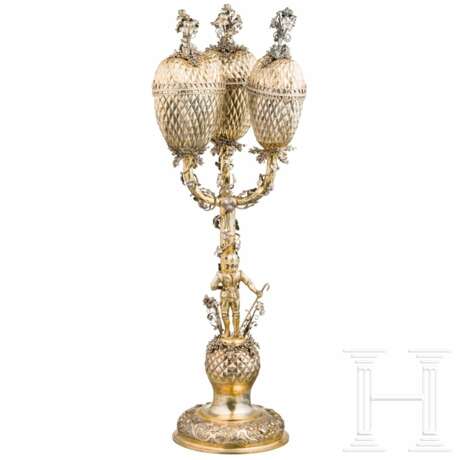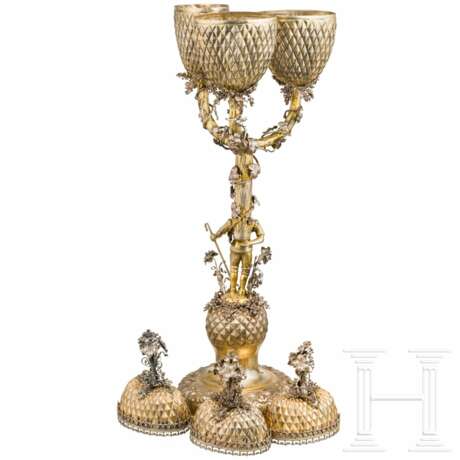ID 548324
Lot 166 | Dreifacher Ananaspokal mit Diamantdekor, deutsch, um 1900
Estimate value
€ 8 800
Silber, gegossen, getrieben, graviert, punziert, teilweise vergoldet. Über rundem Standring mit zwei Punzen ein Wulstfuß mit Bandwerk, diamantierter Kugelknauf, Schaft in Form eines von Weinlaub umrankten Baumes mit Wanderer in historischem Kostüm. Drei Äste mit je einer diamantierten Kuppa und abnehmbarem Deckel. Bekrönung durch Filigransträuße. Vergoldung teilweise berieben. Höhe 54 cm. Gewicht ca. 1400 g.
In der Tradition der Drillingspokale von Georg Müllner (Nürnberg, 1624 – 1647) gefertigt. Es handelte sich um Trinkspiele, die nach dem Prinzip der kommunizierenden Röhren funktionierten. Vgl. „Schatzkunst 800-1800" von Schmidberger/Richter, Staatliche Museen Kassel, 2001, S. 232.
Zustand: II
A German three-branch pineapple trophy set with diamonds, circa 1900
Silver, cast, hammered, engraved, marked, partially gilt. A bulging base with interlaced strapwork on a circular ring stand with two hallmarks, ball knob set with diamonds, the shaft in the shape of a tree entwined with vines with a wanderer in historical costume. Three branches, each with a diamond-studded bowl and removable lid. The finials in the shape of filigree foliage. The gilding rubbed in places. Height 54 cm. Weight approximately 1400 g.
Follows in the tradition of the three-branch trophies made by Georg Müllner (Nuremberg, 1624 - 1647). They were drinking games which worked according to the principle of communicating vessels. Cf. "Schatzkunst 800-1800" by Schmidberger/Richter, Staatliche Museen Kassel, 2001, p. 232.
Condition: II
| Auction house category: | Silver, jewelry and objets de vertu |
|---|
| Auction house category: | Silver, jewelry and objets de vertu |
|---|
| Address of auction |
Hermann Historica Bretonischer Ring 3 85630 Grasbrunn / München Germany | ||||||||||||||
|---|---|---|---|---|---|---|---|---|---|---|---|---|---|---|---|
| Preview |
| ||||||||||||||
| Phone | +49 (0)89 5472 649 0 | ||||||||||||||
| Fax | +49 (0)89 5472 64999 | ||||||||||||||
| Buyer Premium | 25 % | ||||||||||||||
| Conditions of purchase | Conditions of purchase | ||||||||||||||
| Business hours | Business hours
|













